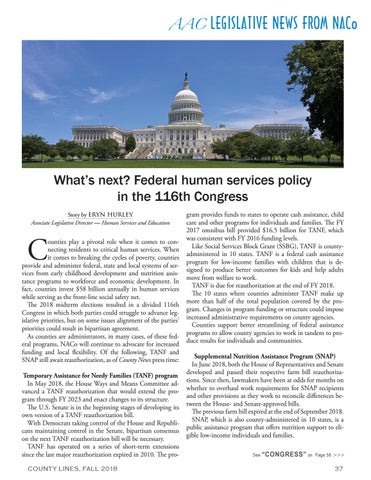AAC
LEGISLATIVE NEWS FROM NACo
What’s next? Federal human services policy in the 116th Congress Story by eryn hurley Associate Legislative Director — Human Services and Education
C
ounties play a pivotal role when it comes to connecting residents to critical human services. When it comes to breaking the cycles of poverty, counties provide and administer federal, state and local systems of services from early childhood development and nutrition assistance programs to workforce and economic development. In fact, counties invest $58 billion annually in human services while serving as the front-line social safety net. The 2018 midterm elections resulted in a divided 116th Congress in which both parties could struggle to advance legislative priorities, but on some issues alignment of the parties’ priorities could result in bipartisan agreement. As counties are administrators, in many cases, of these federal programs, NACo will continue to advocate for increased funding and local flexibility. Of the following, TANF and SNAP still await reauthorization, as of County News press time: Temporary Assistance for Needy Families (TANF) program In May 2018, the House Ways and Means Committee advanced a TANF reauthorization that would extend the program through FY 2023 and enact changes to its structure. The U.S. Senate is in the beginning stages of developing its own version of a TANF reauthorization bill. With Democrats taking control of the House and Republicans maintaining control in the Senate, bipartisan consensus on the next TANF reauthorization bill will be necessary. TANF has operated on a series of short-term extensions since the last major reauthorization expired in 2010. The proCOUNTY LINES, FALL 2018
gram provides funds to states to operate cash assistance, child care and other programs for individuals and families. The FY 2017 omnibus bill provided $16.5 billion for TANF, which was consistent with FY 2016 funding levels. Like Social Services Block Grant (SSBG), TANF is countyadministered in 10 states. TANF is a federal cash assistance program for low-income families with children that is designed to produce better outcomes for kids and help adults move from welfare to work. TANF is due for reauthorization at the end of FY 2018. The 10 states where counties administer TANF make up more than half of the total population covered by the program. Changes in program funding or structure could impose increased administrative requirements on county agencies. Counties support better streamlining of federal assistance programs to allow county agencies to work in tandem to produce results for individuals and communities. Supplemental Nutrition Assistance Program (SNAP) In June 2018, both the House of Representatives and Senate developed and passed their respective farm bill reauthorizations. Since then, lawmakers have been at odds for months on whether to overhaul work requirements for SNAP recipients and other provisions as they work to reconcile differences between the House- and Senate-approved bills. The previous farm bill expired at the end of September 2018. SNAP, which is also county-administered in 10 states, is a public assistance program that offers nutrition support to eligible low-income individuals and families. See
“CONGRESS” on
Page 58
>>>
37


















